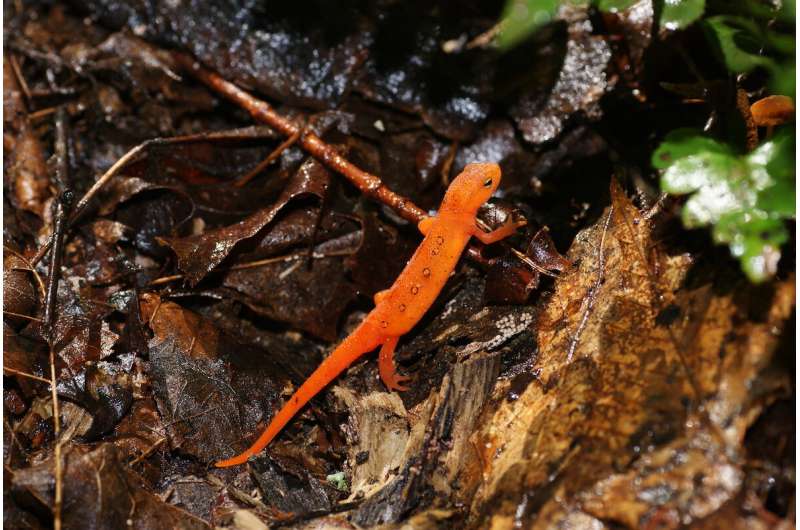This article has been reviewed according to Science X's editorial process and policies. Editors have highlighted the following attributes while ensuring the content's credibility:
fact-checked
peer-reviewed publication
proofread
Researchers find high risk to amphibians if fungal pathogen invades North America

New research indicates the fungal pathogen Batrachochytrium salamandrivorans (Bsal) could be devastating to amphibian biodiversity if introduced to North America.Nature Communications has published the findings from a group of researchers at the University of Tennessee Institute of Agriculture, the University of Massachusetts-Boston and Washington State University.
"We could see over 80 species of salamanders in the United States and 140 species in North America experience population declines if Bsal is introduced," said Matt Gray, the lead author and professor of wildlife health in the UT School of Natural Resources.
Amphibians are an important form of natural mosquito control in our environment. They are also important to medical research because of their ability to regenerate limbs and the natural analgesics (pain killers) they produce. Some of the peptides from their skin can actually inactivate some viruses detrimental to humans, including HIV.
However, Bsal erodes and destroys the skin of amphibians. The fungal pathogen was discovered ten years ago in fire salamander populations in Europe but has not yet been detected in the western hemisphere. The article's authors began experiments evaluating the risk to North American amphibians in 2016.
"Some of our most common salamander species, like the eastern newt, could be wiped out," Gray said. The research predicts the greatest declines could be seen in the Appalachian Mountains and Pacific Northwest, where climate conditions are ideal for Bsal and salamander numbers are the greatest.
"Many of the salamanders in the Smokies are lungless and breath entirely through their skin," said co-author Debra Miller, veterinary pathologist with the UT One Health Initiative. "So a fungus that destroys the skin can affect their ability to respire and maintain healthy levels of important electrolytes in their bodies."
In a separate article in Frontiers in Veterinary Science, Miller and colleagues reported that changes in skin function and electrolytes in the blood from Bsal infection can lead to paralysis, which is often seen in sick animals.
In the Nature article, the authors encourage the U.S., Canada and Mexico to consider developing a healthy trade certification program that promotes the sale of amphibians that are not infected by chytrid fungi and ranaviruses. The article says wildlife trade involves more than 180 nations and generates $300 billion annually.
In another study published in June in Business Strategy and the Environment, Kevin Cavasos, of the UT One Health Initiative; Gray and colleagues report the majority of U.S. businesses support a healthy trade certification program.
Neelam Poudyal, professor of natural resource policy in the UT School of Natural Resources, said, "Our initial surveys of pet amphibian owners suggest they are concerned about these pathogens and may be willing to spend approximately 75% more for amphibians that are not infected."
Gray, Poudyal and others recently began a study to investigate pathogen movements in pet amphibian trade and the willingness of the industry to adopt healthy trade practices.
Gray said, "Wildlife trade can contribute to the global spread of various pathogens, even those that can cause disease in humans. It is important to support healthy trade programs to reduce business losses and threats to our native biodiversity and safeguard public health."
More information about Gray and Poudyal's healthy trade research as well as opportunities for U.S. pet amphibian businesses to receive free pathogen testing can be found at healthyamphibiantrade.org.
More information: Matthew J. Gray et al, Broad host susceptibility of North American amphibian species to Batrachochytrium salamandrivorans suggests high invasion potential and biodiversity risk, Nature Communications (2023). DOI: 10.1038/s41467-023-38979-4
Wesley C. Sheley et al, Electrolyte imbalances and dehydration play a key role in Batrachochytrium salamandrivorans chytridiomycosis, Frontiers in Veterinary Science (2023). DOI: 10.3389/fvets.2022.1055153
Kevin Cavasos et al, Exploring business stakeholder engagement in sustainable business practices: Evidence from the US pet amphibian industry, Business Strategy and the Environment (2023). DOI: 10.1002/bse.3455
Journal information: Nature Communications , Nature
Provided by University of Tennessee Institute of Agriculture


















